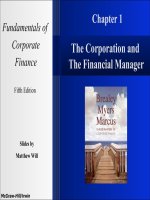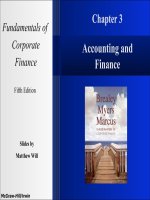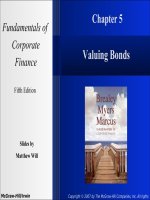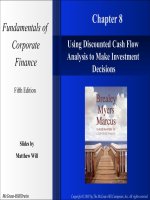Fundamentals of corporate finance 10e ROSS JORDAN chap015
Bạn đang xem bản rút gọn của tài liệu. Xem và tải ngay bản đầy đủ của tài liệu tại đây (1.34 MB, 59 trang )
Chapter 15
Raising Capital
15-1
McGraw-Hill/Irwin
Copyright © 2013 by The McGraw-Hill Companies, Inc. All rights reserved.
Chapter Outline
•The Financing Life Cycle of a Firm: Early-Stage Financing and
Venture Capital
•Selling Securities to the Public: The Basic Procedure
•Alternative Issue Methods
•Underwriters
•IPOs and Underpricing
15-2
Chapter Outline
(continued)
• New Equity Sales and the Value of the Firm
• The Cost of Issuing Securities
• Rights
• Dilution
• Issuing Long-Term Debt
• Shelf Registration
15-3
Chapter Outline
•The Financing Life Cycle of a Firm: Early-Stage Financing and
Venture Capital
•Selling Securities to the Public: The Basic Procedure
•Alternative Issue Methods
•Underwriters
•IPOs and Underpricing
15-4
Venture Capital
• Private financing for relatively new businesses in
exchange for equity
• Usually entails some hands-on guidance
• The company should have an “exit” strategy
Sell the company – VC benefits from proceeds from sale
Take the company public – VC benefits from IPO
15-5
Venture Capital
•Many VC firms are formed from a group of
investors that pool capital and then have
partners in the firm decide which companies
will
receive financing
•Some large corporations have a VC division
15-6
Choosing a Venture Capitalist
• Look for financial strength
• Choose a VC that has a management style that is
compatible with your own
• Obtain and check references
• What contacts does the VC have?
• What is the exit strategy?
15-7
Chapter Outline
•The Financing Life Cycle of a Firm: Early-Stage Financing and
Venture Capital
•Selling Securities to the Public: The Basic Procedure
•Alternative Issue Methods
•Underwriters
•IPOs and Underpricing
15-8
Selling Securities to the Public
1. Management must obtain permission from the Board of Directors
2. Firm must file a registration statement with the SEC
3. The SEC examines the registration during a 20-day waiting period
A preliminary prospectus, called a red herring, is distributed
during the waiting period
If there are problems, the company is allowed to amend the
registration and the waiting period starts over
15-9
Selling Securities to the Public
4. Securities may not be sold during the waiting period
5. The price is determined on the effective date of the
registration
15-10
Chapter Outline
•The Financing Life Cycle of a Firm: Early-Stage Financing and
Venture Capital
•Selling Securities to the Public: The Basic Procedure
•Alternative Issue Methods
•Underwriters
•IPOs and Underpricing
15-11
Alternate Issue Types
15-12
Alternate Issue Types
15-13
Chapter Outline
•The Financing Life Cycle of a Firm: Early-Stage Financing and
Venture Capital
•Selling Securities to the Public: The Basic Procedure
•Alternative Issue Methods
•Underwriters
•IPOs and Underpricing
15-14
Underwriters
Services provided by
underwriters include:
•Formulate method used to issue
securities
•Price the securities
•Sell the securities
•Price stabilization by lead
underwriter
15-15
Underwriters
Syndicate – group of investment
bankers that market the securities
and share the risk associated with
selling the issue
15-16
Underwriters
Spread – difference between what
the syndicate pays the company and
what the security sells for initially in
the market
15-17
Firm Commitment Underwriting
• Issuer sells entire issue to underwriting syndicate
• The syndicate then resells the issue to the public
• The underwriter makes money on the spread
between the price paid to the issuer and the price
received from investors when the stock is sold
15-18
Firm Commitment Underwriting
• Issuer sells entire issue to underwriting syndicate
The syndicate bears the risk of not being able to sell
the entire issue for more than the cost
This is the most common type of underwriting in the
United States
15-19
Best Efforts Underwriting
•Underwriter must make their “best effort” to sell the
securities at an agreed-upon offering price
•The company bears the risk of the issue not being sold
•The offer may be pulled if there is not enough interest at the
offer price. In this case, the company does not get the capital,
and they have still incurred substantial flotation costs
15-20
Dutch Auction Underwriting
•Underwriter accepts a series of bids that include number of shares
and price per share
•The price that everyone pays is the highest price that will result in
all shares being sold
•There is an incentive to bid high to make sure you get in on the
auction but knowing that you will probably pay a lower price than
you bid
• (The US Treasury has used Dutch auctions for years!)
15-21
Green Shoe Provision
• Allows the syndicate to purchase an
additional 15% of the issue from the
issuer
• Allows the issue to be oversubscribed
• Provides some protection for the
underwriters as they perform their price
stabilization function
15-22
Lockup Agreements
•Restriction on insiders that prevents them
from selling their shares of an IPO for a
specified time period
•The lockup period is commonly 180 days
•The stock price tends to drop when the
lockup period expires due to market
anticipation of additional shares hitting the
street
15-23
Chapter Outline
•The Financing Life Cycle of a Firm: Early-Stage Financing and
Venture Capital
•Selling Securities to the Public: The Basic Procedure
•Alternative Issue Methods
•Underwriters
•IPOs and Underpricing
15-24
IPO Underpricing
• May be difficult to price an IPO because there isn’t a
current market price available
• Private companies tend to have more asymmetric
information than companies that are already publicly
traded
15-25









